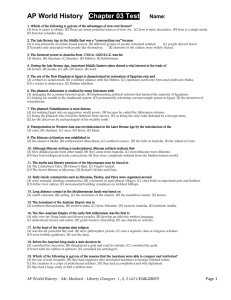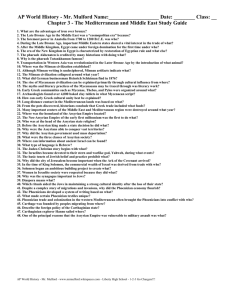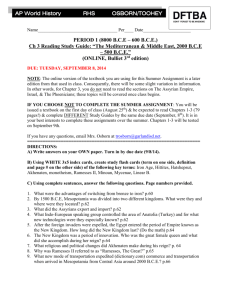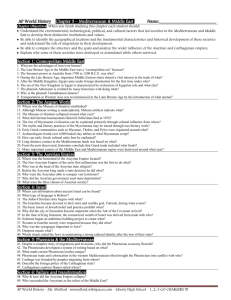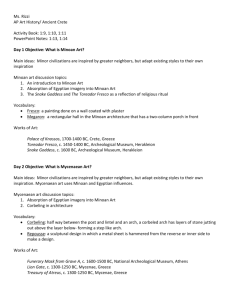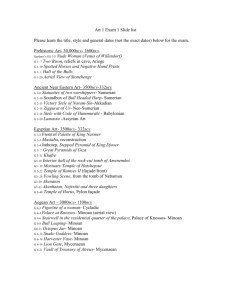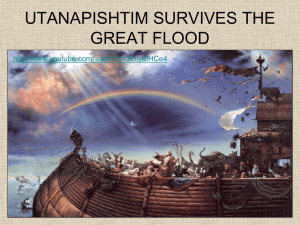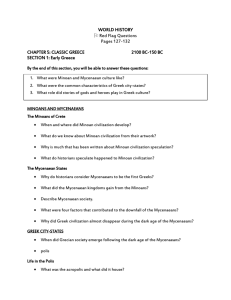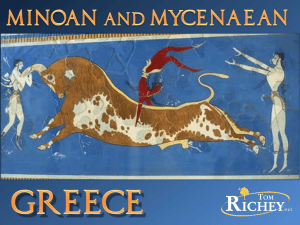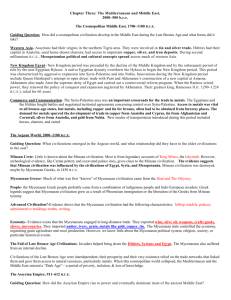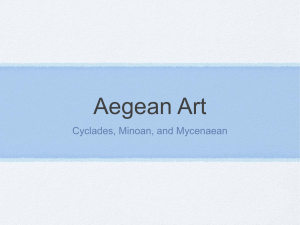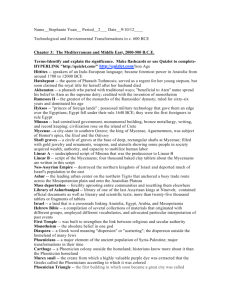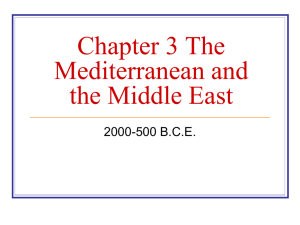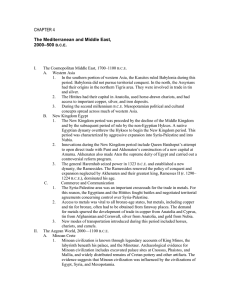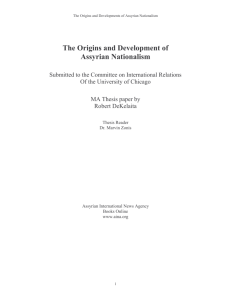AP World History Chapter 03 Test
advertisement
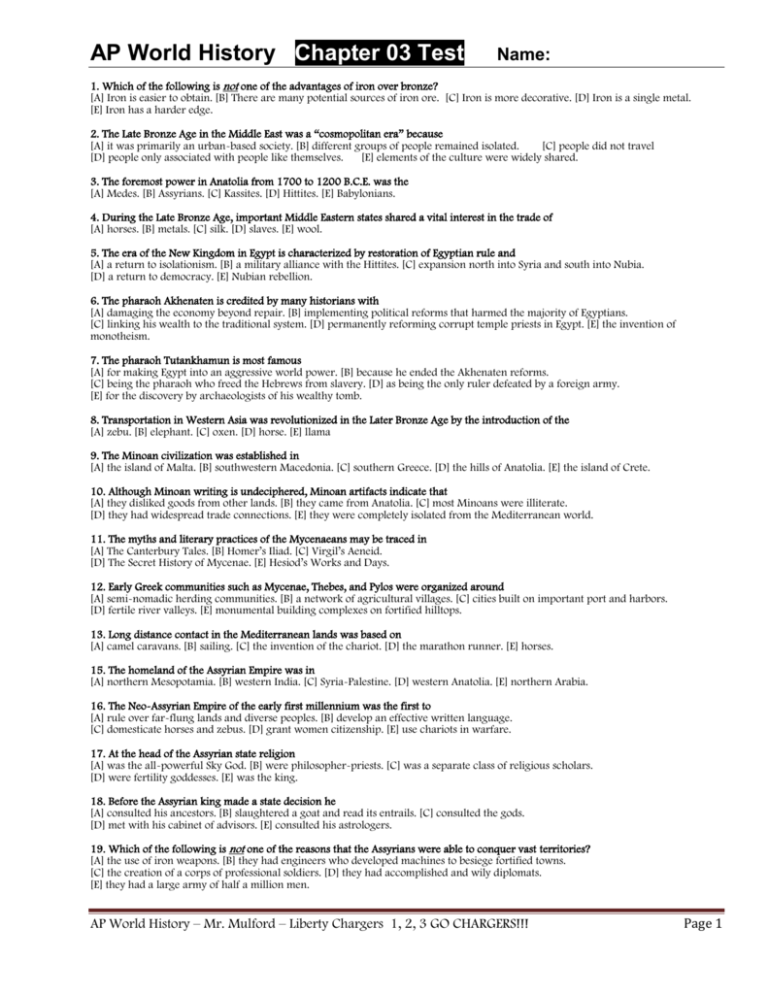
AP World History Chapter 03 Test Name: 1. Which of the following is not one of the advantages of iron over bronze? [A] Iron is easier to obtain. [B] There are many potential sources of iron ore. [C] Iron is more decorative. [D] Iron is a single metal. [E] Iron has a harder edge. 2. The Late Bronze Age in the Middle East was a “cosmopolitan era” because [A] it was primarily an urban-based society. [B] different groups of people remained isolated. [C] people did not travel [D] people only associated with people like themselves. [E] elements of the culture were widely shared. 3. The foremost power in Anatolia from 1700 to 1200 B.C.E. was the [A] Medes. [B] Assyrians. [C] Kassites. [D] Hittites. [E] Babylonians. 4. During the Late Bronze Age, important Middle Eastern states shared a vital interest in the trade of [A] horses. [B] metals. [C] silk. [D] slaves. [E] wool. 5. The era of the New Kingdom in Egypt is characterized by restoration of Egyptian rule and [A] a return to isolationism. [B] a military alliance with the Hittites. [C] expansion north into Syria and south into Nubia. [D] a return to democracy. [E] Nubian rebellion. 6. The pharaoh Akhenaten is credited by many historians with [A] damaging the economy beyond repair. [B] implementing political reforms that harmed the majority of Egyptians. [C] linking his wealth to the traditional system. [D] permanently reforming corrupt temple priests in Egypt. [E] the invention of monotheism. 7. The pharaoh Tutankhamun is most famous [A] for making Egypt into an aggressive world power. [B] because he ended the Akhenaten reforms. [C] being the pharaoh who freed the Hebrews from slavery. [D] as being the only ruler defeated by a foreign army. [E] for the discovery by archaeologists of his wealthy tomb. 8. Transportation in Western Asia was revolutionized in the Later Bronze Age by the introduction of the [A] zebu. [B] elephant. [C] oxen. [D] horse. [E] llama 9. The Minoan civilization was established in [A] the island of Malta. [B] southwestern Macedonia. [C] southern Greece. [D] the hills of Anatolia. [E] the island of Crete. 10. Although Minoan writing is undeciphered, Minoan artifacts indicate that [A] they disliked goods from other lands. [B] they came from Anatolia. [C] most Minoans were illiterate. [D] they had widespread trade connections. [E] they were completely isolated from the Mediterranean world. 11. The myths and literary practices of the Mycenaeans may be traced in [A] The Canterbury Tales. [B] Homer’s Iliad. [C] Virgil’s Aeneid. [D] The Secret History of Mycenae. [E] Hesiod’s Works and Days. 12. Early Greek communities such as Mycenae, Thebes, and Pylos were organized around [A] semi-nomadic herding communities. [B] a network of agricultural villages. [C] cities built on important port and harbors. [D] fertile river valleys. [E] monumental building complexes on fortified hilltops. 13. Long distance contact in the Mediterranean lands was based on [A] camel caravans. [B] sailing. [C] the invention of the chariot. [D] the marathon runner. [E] horses. 15. The homeland of the Assyrian Empire was in [A] northern Mesopotamia. [B] western India. [C] Syria-Palestine. [D] western Anatolia. [E] northern Arabia. 16. The Neo-Assyrian Empire of the early first millennium was the first to [A] rule over far-flung lands and diverse peoples. [B] develop an effective written language. [C] domesticate horses and zebus. [D] grant women citizenship. [E] use chariots in warfare. 17. At the head of the Assyrian state religion [A] was the all-powerful Sky God. [B] were philosopher-priests. [C] was a separate class of religious scholars. [D] were fertility goddesses. [E] was the king. 18. Before the Assyrian king made a state decision he [A] consulted his ancestors. [B] slaughtered a goat and read its entrails. [C] consulted the gods. [D] met with his cabinet of advisors. [E] consulted his astrologers. 19. Which of the following is not one of the reasons that the Assyrians were able to conquer vast territories? [A] the use of iron weapons. [B] they had engineers who developed machines to besiege fortified towns. [C] the creation of a corps of professional soldiers. [D] they had accomplished and wily diplomats. [E] they had a large army of half a million men. AP World History – Mr. Mulford – Liberty Chargers 1, 2, 3 GO CHARGERS!!! Page 1 20. The Assyrian government used mass deportation to [A] thin out the population in congested areas. [B] break the spirit of rebellious peoples. [C] get rid of the criminal population. [D] settle newly conquered territories. [E] solve the problems of famine in the empire. 21. The three classes of Assyrian society were [A] knights, serfs, and semi-serfs. [B] merchants, warriors, and peasants. [C] nobility, philosophers/bureaucrats, and slaves. [D] scholars, merchants, and slaves. [E] landowners, dependent farmers, and slaves. 22. Information about ancient Israel can be found in the [A] Rig Veda. [B] Rosetta Stone. [C] Chronicles of Abraham. [D] Poems of Saul. [E] Hebrew Bible. 23. Hebrew is a [A] Indo-European language. [B] Altaic language. [C] Slavic language. [D] Semitic language. [E] Bantu language. 24. The basic tenets of Jewish belief and practice prohibit [A] banking, trading, and travel. [B] murder, adultery, theft, and lying. [C] facial hair, pastoralism, and mercantile trade. [D] alcohol consumption, meat eating, and violence. [E] gambling, money-lending, and begging. 25. When the Ark of the Covenant was brought to Jerusalem, the city became [A] closed to all but the faithful. [B] the political and religious center of the kingdom of Israel. [C] the focal point for enemies. [D] a neutral and “open” city free from attack from its neighbors. [E] the center of Persian religious pilgrimages. 26. Solomon began an ambitious building project to create [A] the Wailing Wall. [B] the Israeli Museum of Art. [C] the Library of Alexandria. [D] the First Temple. [E] the walled city of Jerusalem. 27. The synagogue was important during and after the diaspora because it gave Jews [A] a political refuge during the diaspora. [B] a means to form a monotheistic religion. [C] an institution to maintain their culture outside the homeland. [D] a place to store their grain. [E] lodging during long trips. 28. Diaspora means [A] dissatisfaction. [B] scattering. [C] faith. [D] separation. [E] fulfillment. 29. The Phoenicians developed a system of writing based on [A] Turkish writing. [B] Mesopotamian cuneiform. [C] later Egyptian hieroglyphics. [D] pictograms, which were similar to Chinese writing. [E] an alphabet, where each symbol represented a sound. 30. Carthage was founded by peoples migrating from [A] Arabia. [B] Greece. [C] Egypt. [D] Phoenicia. [E] Rome. 31. Which of the following best describes how the Assyrians treated the people they conquered? [A] The king ruled directly over the conquered people [B] Freedom and autonomy were granted to conquered [C] Mass deportation and terror were used to maintain control [D] Wealth was channeled to the outlying areas to create peace [E] In an effort to control subjects, all long-distance trade was halted. 32. The Israelites were unique in the region because of their [A] location along the Mediterranean Sea and involvement in trade [B] continued existence as nomadic herdsmen and traders [C] wealth of natural resources [D] successful resistance to the Neo-Assyrian Empire [E] belief in monotheism 33. Which of the following statements best describes the economic and political nature of the Minoan & Mycenaean civilizations? [A] Minoan and Mycenaean homelands had vast natural resources [B] Minoans had greater economic influence than the Mycenaeans. [C] Minoan and Mycenaean societies relied heavily on trade [D]Minoans were more aggressive than the isolated Mycenaeans. [E] Minoan and Mycenaean civilizations frequently were at war with one another 34. The most lasting contribution of the Phoenicians was [A] A model for creating a trade-based civilization that would be followed by subsequent groups in the region. [B] A new approach to knowledge that challenged existing modes of thought and is the basis of Western philosophy. [C] Developments in naval technology that enabled the Phoenicians to fend off Persian advances into the Mediterranean. [D] An alphabetic system of writing that used symbols for sounds instead of for whole words. [E] A democratic form of government that the Greeks used as a model for their system. 35. What factor did not account for the Assyrians’ success in creating their empire? [A] They had a large army that used horseback warfare. [B] They made and used iron weapons. [C] Deliberate ruthless foreign policy. [D] They treated their subject peoples with leniency. [E] They deported the people they conquered back to the Assyrian homeland. 36. Which people developed the world’s first true alphabet? [A] The Lydians [B] The Phoenicians [C] The Hebrews [D] The Persians [E] The Egyptians AP World History – Mr. Mulford – Liberty Chargers 1, 2, 3 GO CHARGERS!!! Page 2
